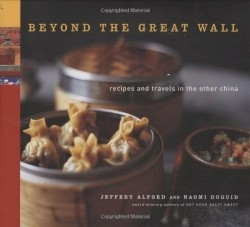Beyond the Great Wall
Recipes and Travels in the Other China
Food partisans in the United States too often view the nation’s restaurant scene as two coasts separated by a culinary wasteland. The interior “fly-over” regions might not be totally disregarded but the nods are flippant and patronizing. Outside the prejudicial confines of New York, Los Angeles, and San Francisco, only a few chef-prophets like Charlie Trotter and Rick Bayless in Chicago, Dean Fearing in Dallas, and Birmingham’s Frank Stitt warrant attention.
China is also fragmented, yet there the divisions are both ethnically and regionally conveniently demarcated by the Great Wall; indeed, the Wall serves a purpose beyond tourist attraction. Before discussing food attitudes, it is important to realize that in the minds of the Han Chinese, anyone living on the other side of the Wall is not culturally Chinese. No matter that three-fifths of the land area we now know as China falls “over there.” And even while China experiences unrivaled economic growth, the non-Han Chinese remain second-class citizens.
But food and cooking is our topic, and a monumental new book by the acclaimed duo of Jeffrey Alford and Naomi Duguid seeks to redraw the food map of China. Beyond the Great Wall takes us inside the kitchens of Inner Mongolia, Tibet, Yunnan, and other far off regions, showcasing “the diversity, the ingenuity, the resourcefulness, the incredible depth of history, tradition, and culture—all of these things make food in China, and eating in China, one of life’s great pleasures.” In light of China’s rapid changes, Alford and Duguid seek to document the food and culture for safe-keeping; as an act of preservation and cultural survival for China’s smaller societies “faced with the impact of a giant at the doorstep.” Remember, China only opened its borders in the early eighties, a time when much of the country was living as they did hundreds of years ago.
With thirteen non-Han societies to explore, the authors wisely choose to organize the book by food type and ingredient. Chapter heads include Condiments and Seasonings, Soups, Salads, Mostly Vegetable, Noodles and Dumplings, Rice and Grains, Breads, Fish, Chicken and Eggs, Lamp and Beef, Pork and finally, Drinks and Sweet Treats leading to 125 recipes. Be assured, you will not stumble upon MSG-laden, General Tso’s Chicken-style recipes herein. Neither will you see ultra-fancy dishes for ceremonial dinners or posh parties. All of which points to the rural, humble, working class mindset known to the regions in question.
Thousands of miles east of Beijing and Shanghai, the Central Asian dishes will most surprise. Think cumin-spiced kebabs, flatbreads, and Succulent Lamb Samsa, a stuffed-bread equivalent to Indian samosa from the Xinjiang region. Mongolian fare is represented by dishes like Hot Pot with lamb, mushrooms, tofu, and red dates, but also by headturners including Beef-Sauced Hot Lettuce Salad assertively flavored with fresh ginger and garlic and pungent black rice vinegar.
The recipes are exhaustingly detailed and never intimidating. As in their previous books, Alford and Duguid rely on deft writing skills to make each recipe, cooking technique, and dish description seem a rare, singular achievement. In actuality, Beyond the Great Wall will most likely spend more time on coffee tables than kitchen counters due to the superlative travel and political writing. To be sure, many of the areas visited are as remote and foreign as any on Earth. This is not easy traveling. Credit goes to the two explorers for staying vigilant to their mission when simply locating a hot meal at the end of the day would qualify as miraculous for most travelers.
Reviewed by
Matt Sutherland
Disclosure: This article is not an endorsement, but a review. The publisher of this book provided free copies of the book to have their book reviewed by a professional reviewer. No fee was paid by the publisher for this review. Foreword Reviews only recommends books that we love. Foreword Magazine, Inc. is disclosing this in accordance with the Federal Trade Commission’s 16 CFR, Part 255.

